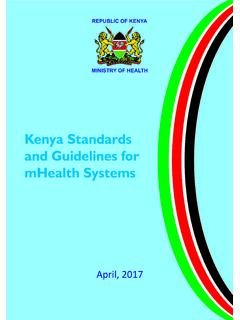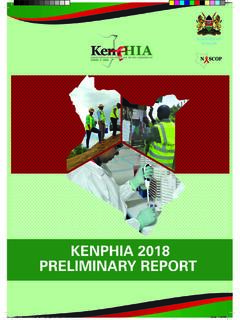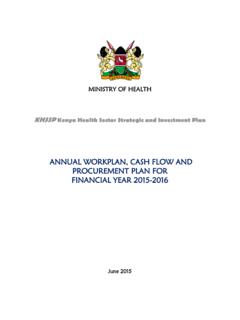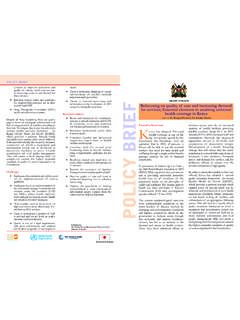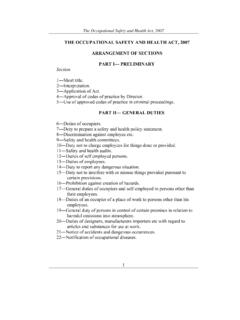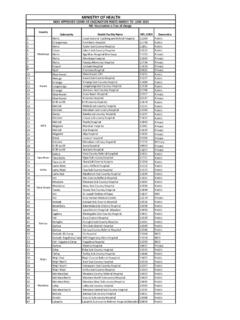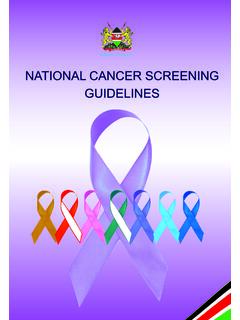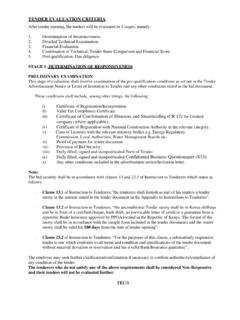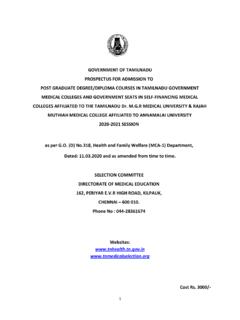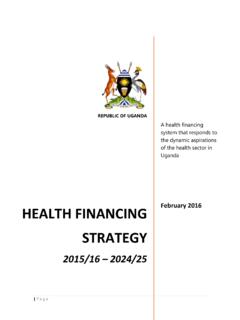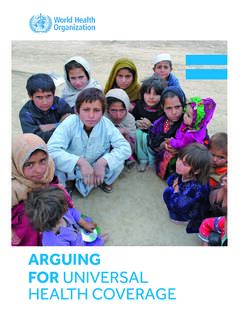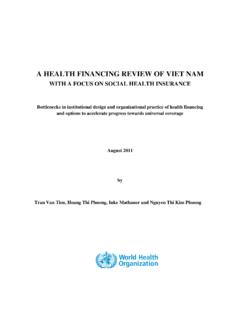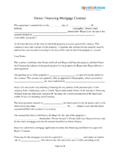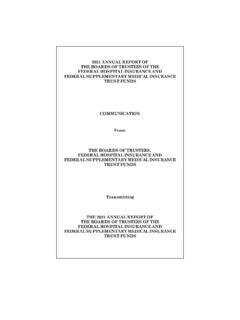Transcription of Healthcare Financing Policy Brief - Government of Kenya
1 BRIEFPOLICYA Case for Increasing Public Investments in HealthRaising Public Commitments to Kenya s Health SectorMINISTRY OF HEALTHE xecutive StatementIn Kenya , percent of sick Kenyans do not seek health care when they are ill with high cost of services being one of the major barriers that accounted for upto 21 percent of those who did not seek care in 2013. Further, million Kenyans ( percent) of households were at risk of impoverishment as a consequence of expenditure on health care depleting household savings and were at a risk of falling into poverty (Republic of Kenya 2015b).Key Messages:The main challenge of Healthcare access in Kenya lies primarily in the acute scarcity of resources, and inadequate resource allocation. In the past few decades, the out-of-pocket (OOP) expenditure has been increasing since the introduction of user fees in the health sector.
2 Moreover, to limit the rising publicly-financed health expenditures, OOP expenditures have continued to be implemented in the country consequently leading to burdening social subgroups unequally. To address these barriers, this Brief calls for the Kenyan Government to: Seize this period of strong economic growth to prioritize investments in health, particularly key areas such as maternal and child health that are fundamental to a healthy population; Reduce the burden on poor households of out-of-pocket spending on health by expanding alternative Financing sources such as health insurance subsidies and vouchers for key services and by partnering with the private health sector; Address missed opportunities in implementing high impact preventive interventions. Strengthen community-based care and address gaps in human resources for health. Author ~ Njuguna David and Pepela WanjalaIntroductionThe general aspiration of the Kenya vision 2030 is to transform the country into a globally competitive and prosperous industrialized, middle-income country.
3 In line with Vision 2030 and the Constitution of Kenya 2010, the Government is committed to implementing strategic interventions aimed at accelerating the attainment of Universal Health Coverage (UHC) for all Kenyans. Kenyan health sector has an articulate and elaborate Kenya Health Policy (KHP 2014 -2030) to assist the sector realign to new emerging issues to enable the country attain its long term Health goal sought by the country as outlined in the Kenya s vision 2030 and the Kenyan Constitution 2010. Over the last decade, Kenya s strong economic growth has led to tripling of Government expenditures across all sectors. With continued projected economic growth of above 5 percent, Kenya has an opportunity to reform its health sector (Economic Survey 2017). However, Government expenditures on health as a percentage of total Government expenditures has stagnated around 6 percent ( Kenya NHA Reports year).
4 This puts Kenya farther from its goal of increasing health expenditures to 12 percent of total Government expenditures as set in the Kenya Health Sector Strategic and Investment Plan (KHSSP) 2010, points out that or a country to achieve Universal health Coverage, then it should dedicate more resources to health. While raising more money for health is crucial in supporting the UHC agenda, it is just as important to get the most out of the resources available. In order to ensure financial risk protection for all, provision of essential package of health should be funded primarily through prepayment mechanisms, while reducing OOP payments to a very lack of adequate financial protection is attributed to low funding, fragmentation of resources and low insurance coverage. Direct OOP places the burden of bearing the costs of illness to the sick person and their families, and is therefore a major contributor to inequities.
5 According to WHO (2010), incidence of financial catastrophe and impoverishment falls to negligible levels only when direct OOP falls between 15-20 percent of Total Health Expenditure (THE). This Brief addresses Kenya s health care Financing , based on evidence generated by the Kenya National Health Account (NHA) estimation of 2015/16. NHA is an international methodology that tracks flow of resources in a country s health system including volume of expenditures, sources of Financing , types and levels of care provided, as well as the providers who deliver services. NHA findings are intended to inform the decisions of policymakers seeking to improve health system efficiency. BackgroundThe average life expectancy in 2016 was years, up from 51 years in 20041. The population growth rate has remained high at per year, with a large number of young and dependent population that is increasingly in the economically productive age-group (15 64 years), were estimated at about percent of the population according to the Economic Survey 2017.
6 In absolute numbers, this amounts to million Kenyans. The total labor workforce stood at 15 million Kenyans, with the balance of about 8 million not in employment. In 2016, employment increased by per cent to million persons. Informal sector employment increased by per cent to million persons, and accounted for percent of total persons engaged during the review period. Migration from rural to urban areas, most noted among people ages 20 34 years, has contributed to an increase in the urban population and their associated health risks mostly affecting the urban informal settlements in the rebasing of the country s economy to lower middle-income country has necessitated some development partners to drastically reduce their support as per international benchmarks related to such support.
7 The country is now expected to contribute above 20 per cent for basic commodities such as vaccines, Malaria, TB, Family Planning and ARVs instead of a minimum of 5 per cent previously. Coverage of critical interventions related to maternal and child health have shown signs of improvement, as shown by trends in the Demographic and Health Surveys. Although Kenya did not achieve the health Millennium Development Goals (MDGs) by end of 2015, the health sector has recorded significant progress in improving maternal and child health indicators. Infant Mortality Rate (IMR) reduced from 77 per 1,000 live births in 2003 to 39 in 2014 and Under-five Mortality Rate (UMR) reduced to 115 per 1000 live births in 2003 to 52 in 2014. However, neonatal mortality remained high contributing about 35% of the Infant mortality rate. On maternal health, the Maternal Mortality Ratio (MMR) remained high at 362 deaths per 100,000 live births against a global trend of declining MMR from 400 to 210 deaths per 100,000 live births in 1990 and 2010 respectively.
8 The causes of maternal deaths are well known and manageable, when women access timely care from skilled providers. Maternal deaths not only affect families, but have serious negative impacts on the country s economic The Total Health Expenditure (THE) in Kenya was KSh 346 billion (USD 3,476 million) in 2015/16, up from KSh 271 billion (USD 3,188 million) in 2012/13. Total health spending in 2015/16 accounted for of GDP down from in 2012/13. The Government budgetary allocation to health has remained low relative to global commitments like the Abuja declaration of 15 percent allocation of the total Government allocation to health. The Government expenditure on health as a percent of total Government expenditure increased from in 2012/13 to % in 2015/16. Similarly, the level of external funding has been relatively high, with a significant share of such funding being off-budget.
9 The external Financing for the health sector accounted for 22 percent of Current Health Expenditures (CHE) in 2015/16 down from 32 percent in 2009/10. In net present values, the per capita expenditure in USD has increased from KSh 6,602 (USD ) in 2012/13 to KSh 7,822 (USD ) in 2015/16. The per capita expenditure, Government health expenditure as a percent of THE and the proportion of GDP spent on health has been increasing since 2001/02 to the 2010 World Health Report on Financing for UHC Countries whose entire populations have access to a set of services usually have relatively high levels of [mandatory] pooled BRIEFPOLICY funds in the range of 5 6% of gross domestic product (GDP). Kenya spent % of pooled funds in 2015/16 on , the population having access to health insurance averages 17 percent.
10 However, the rate of insurance coverage is higher for urban population (27 percent) compared with rural population (12 percent). Health insurance coverage is positively correlated to wealth in that insurance coverage is higher in the richest wealth quintiles at 42 percent compared with those in the poorest quintile at 3 percent (Republic of Kenya , 2015b).There has been an increase in Government investment in new initiatives as the country moves towards universal coverage. One being the introduction of new mechanisms of Financing and reducing financial burden of the poor and vulnerable groups. Examples of these are the abolishing of user fees, free maternity, managed equipment and Health Insurance Subsidy Programme (HISP). Success stories include counties like Makueni county where fees have been abolished in all public health facilities making it free for their citizen.
